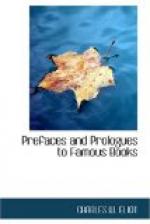Furthermore, we would encourage the artist to gain knowledge also of the inorganic world; this can be done all the more easily since now we can conveniently and quickly acquire knowledge of the mineral kingdom. The painter needs some knowledge of stones in order to imitate their characteristics; the sculptor and architect, in order to utilize them; the cutter of precious stones cannot be without a knowledge of their nature; the connoisseur and amateur, too, will strive for such information.
Now that we have advised the artist to gain a conception of the general operations of Nature, in order to become acquainted with those which particularly interest him, partly to develop himself in more directions, partly to understand better that which concerns him; we shall add a few further remarks on this significant point.
Up to the present the painter has been able merely to wonder at the physicist’s theory of colors, without gaining any advantage from it. The natural feeling of the artist, however, constant training, and a practical necessity led him into a way of his own. He felt the vivid contrasts out of the union of which harmony of color arises, he designated certain characteristics through approximate sensations, he had warm and cold colors, colors which express proximity, others which express distance, and what not; and thus in his own way he brought these phenomena closer to the most general laws of Nature. Perhaps the supposition is confirmed that the operations of Nature in colors, as well as magnetic, electric, and other operations, depend upon a mutual relation, a polarity, or whatever else we might call the twofold or manifold aspects of a distinct unity.
We shall make it our duty to present this matter in detail and in a form comprehensible to the artist; and we can be the more hopeful of doing something welcome to him, since we shall be concerned only with explaining and tracing to fundamental principles things which he has hitherto done by instinct.
So much for what we hope to impart in regard to Nature; now for what is most necessary in regard to Art.
Since the arrangement of this work proposes the presentation of single treatises, some of these only in part, and since it is not our desire to dissect a whole, but rather to build up a whole from many parts, it will be necessary to present, as soon as possible and in a general summary, those thing’s which the reader will gradually find unfolded in our detailed elaborations. We shall, therefore, be occupied first with an essay on plastic art, in which the familiar rubrics will be presented according to our interpretation and method. Here it will be our main concern to emphasize the importance of every branch of Art, and to show that the artist must not neglect a single one, as has unfortunately often happened, and still happens.
Hitherto we have regarded Nature as the treasure chamber of material in general; now, however, we reach the important point where it is shown how Art prepares its materials for itself.




